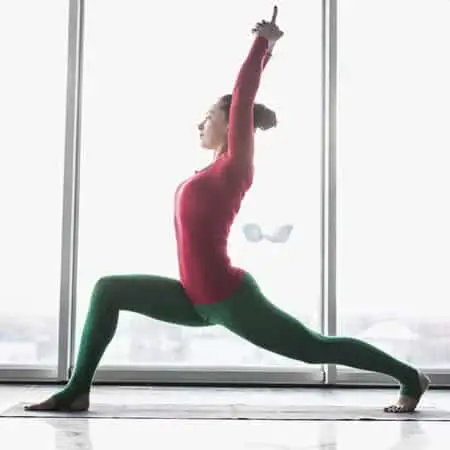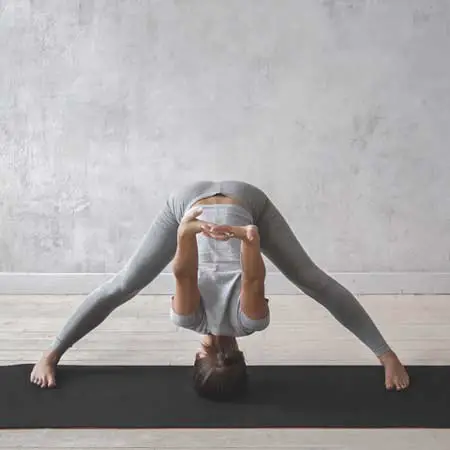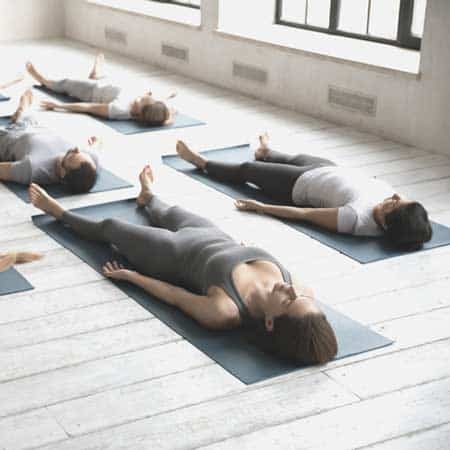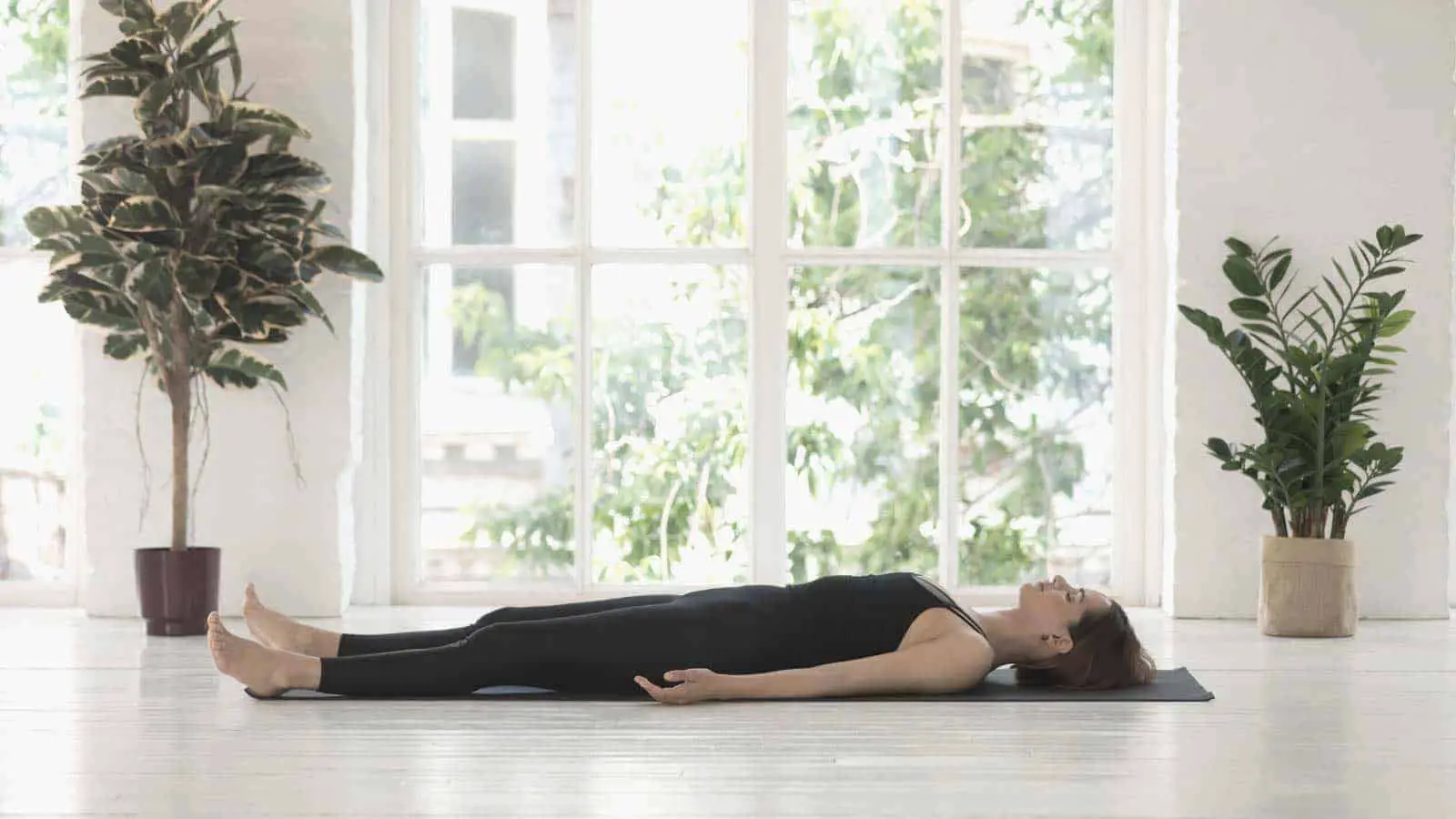Practicing yoga is a fantastic way to strengthen both your body and mind. Having a good yoga mat is a key piece of being able to practice yoga properly. Whether you’ve just started or looking to give another type of yoga a try, you should know how long your yoga mat should be.
A yoga mat should be about 15-25 cm (7-10 inches) longer than your height for optimum comfort. This extra length is advised to prevent from slipping off the mat during the practice.
While that’s the simple answer, there is no “one rule” to fit everyone’s needs. Some types of yoga don’t require such long mats; others require mats of a different shape. To help you figure out how long your mat should be, we’ve put together a list of 5 questions below.
Dimensions for a Yoga Mat
While the length of your mat is going to vary, there are some standard sizes to remember:
Standard Yoga Mat: 172 – 177 cm / 68 to 70 inches long
Tall Yoga Mat: 180 – 190 cm / appx 70 to 75 inches long
Extra Long Mats: 190 – 215 cm / 75 to 84+ inches long
There are many different lengths of mat depending on the manufacturer, but those are the most common size ranges for each category.
How exactly do you go about finding the length you need? Just answer these 5 questions below to help you find out.
How Long Is Your Stride?
Many poses in all different schools of yoga have your legs extended in a long stride. Since this is a key pose, you need to make sure your chosen mat can fit your whole stride.
Normally, your “stride” refers to the distance between your feet while you’re walking normally. However, to measure a yoga mat, your stride refers to the distance between your feet as you do a deep lunge forward.
Option One: Measure Your Stride Yourself

In order to measure your stride, you’ll need a few things:
- A measuring tape or yardstick
- Shoes that won’t slip
- (Optional) A spotter to make sure you don’t tip over
Grab those things, then find a good open spot where you have lots of room to move forward. If you don’t have a spotter, consider doing this next to a wall to help you balance, especially if you are new to yoga.
- Place one end of the tape measure on the floor, and tape it in place if need be
- Extend it 2 – 2.5 m (7-8 feet) out, then tape the other side down
- Place your heels at 0
- Carefully stretch one foot forward into a lunge, extending as far forward as is comfortable
- Carefully slide your back foot forward to meet your front, so you are standing straight again (be careful not to move your front foot)
- Wherever your toes end is the length of your stride
Option Two: Estimate Your Stride
If you don’t have a measuring tape or space to measure your stride properly, you can use a little math to estimate your average stride based on your height. This method isn’t as precise as the above one, but it could give you a decent idea as to how long your stride is.
- Take your height in centimeters or inches
- If you are a woman, multiply it by 0.413
- If you are a man, multiply it by 0.415
- That number is your average walking stride length, so double it in order to get an estimate for how long your stretched yoga stride is
Plan for Growth
No matter what method you use to get your stride, remember that yoga is a physical exercise. Over time, like any other exercise, your body will get stronger and more limber, so your stride is almost certainly going to grow by a few centimeters/inches.
If your stride puts you right at the edge of a mat, buy a size up to give yourself space to grow. It’s also best to have extra room anyway, to prevent your feet from slipping off the mat.
How Wide Is Your Stance?
Another common yoga stance is a pyramid-shaped stance, with both feet slid out to the side while you face forward. Just like your stride, this can help you determine how long your mat needs to be.
How to Measure Your Stance

Measuring your stance is very much like measuring your stride. Here’s what you’ll need:
- A measuring tape or yardstick
- Grippy shoes (this is very important for safety)
- An open space
- (Optional) A spotter
Once you have all of those things together, measure your stance by:
- Taping both ends of the tape measure down, or making sure they stay in place some other way
- If you don’t have a spotter, we recommend you do this facing a wall to help you balance
- Stand with the outside edge of your right foot on 0
- While facing forwards, move your left foot as far to the left as you can, going into a goddess pose (often called a “sumo squat”)
- Move your right foot over to meet your left
- The outside edge of your left footmarks how long your stance is
Realize Your Stance Will Get Wider
Your stance will generally be shorter than your stride, especially if you are new to yoga. However, it’s more important that a mat fits your stance rather than your stride.
When you’re in a goddess pose or anything like it, there’s a lot of pressure and force pushing down and away from your body. Because of this, it’s extremely important that there is plenty of yoga mat on either side of your feet to prevent your foot from slipping off the edge. Just like your stride, you are likely to see a lot of growth in this area, too, so plan for that.
If your foot slips off the edge during an intense pose, it could strain a muscle or worse! Make sure you aren’t slipping off the edge of the mat during this pose.
How Tall Are You?

In order to figure out what length of a yoga mat you will need, you simply work off your height. While you typically won’t be using your full height on a yoga mat, there are some poses, like corpse pose (Shavasana (Shuh-Vah-Sun-aa), also spelled Savasana), that require it.
Quick and easy count: Take your height in centimeters and add 20 (cm), or in inches, then add about 8 (inches). This is a quick and easy way to find a mat that you know will fit all the poses you’ll be doing. However, this might give you a mat that’s longer than you need, so take the other things we’ve talked about into account as well.
Do You Really Need a Mat the Length of Your Whole Body?
Yes! In fact, you usually need a mat that is the length of your body plus a few cm/ inches of room. This gives you enough room to be able to confidently do poses without worrying your feet or hands will slip off the edge.If your mat is too short, it could lead to:
- You being forced to touch the dirty floor with your hands and feet
- Your head or feet hanging off the edge when in certain poses
- Your hands or feet slipping off the edge, resulting in unbalance and maybe even injury
This is why it’s so important to have a properly sized mat.
Do You Move It Often?
Safety and comfort aren’t the only things to think about when choosing a yoga mat, however. Many people take yoga classes, do yoga at work, or otherwise have situations where their mat needs to be portable as well. A longer mat can mean less portability and more bulk.
Portability Vs. Thickness, How Do You Choose?
Choosing the right balance between length and portability all depends on your situation. However, you should never have a mat so short that you are slipping off during poses.
Here are some pros and cons of a longer mat:
There are some pros and cons of a longer mat:
+ Extra room to prevent slipping during difficult poses
+ Gives you room to stretch and grow
+ Ends could be folded over to give more cushion during certain poses
-Bulkier and heavier
-May be harder to fit in classroom settings, or take up too much space
What Style of Yoga are You Doing?
Since there are many different types of yoga, there are different needs for each yoga mat. If you’re in a class that does standing poses, like a physical therapy class, then the extra length on a mat could just be unnecessary bulk or vice versa.
Ultimately, a well-fitted mat like we talked about above will work for any type of yoga. However, there are still considerations to be made depending on what exact class you are in.
You May Do Poses Off-the Mat
In some yoga classes, you may end up doing poses or other exercises that don’t take place on a mat for one reason or another.
It’s one thing to keep in mind when buying a mat—do you really need the ultra-long, super-plush bulky mat if you won’t even be on it half the time?
Buy a mat that suits the needs of your yoga style and skill level.
Can A Yoga Mat Be Too Long?
Ok, so a short mat can be inconvenient and a safety hazard. What about an extra-long mat? Can a yoga mat be too long?
The short answer is no, probably not, but you could switch to a shorter mat if it’s more convenient, and the length is unnecessary. We’ll go through a couple of considerations below.
Longer Mats Encourage Good Form
One of the purposes of yoga is to help you clear your mind and have good focus—so constantly being worried about your hands slipping off the front of your mat during downward dog seems counterproductive!
In fact, having a mat with lots of room encourages you to confidently strike whatever pose you need without worrying about slipping off or touching the gross floor. It frees you to focus on what matters during a yoga session.
Longer Mats Do Take Up More Space
The main downside of having a longer mat is the space it takes up, both on the floor and when packed.
Longer mats can be considerably bulkier and heavier when made from the more cushioned materials. This might seem trivial at first, but after lugging it around every day, you might think twice. If you’re confident in the size of mat you need, then it can be handy to carry only the length you need and not an inch more.
What Can You Do if You Have a Short Mat?
There are several reasons you could find yourself with a mat that’s too short:
- You bought it accidentally or without measuring first
- It was an older yoga mat, and you’ve outgrown it
- You’ve been practicing a while, and you can stretch much further than before
No matter the reason, having a yoga mat that is too short is frustrating and can be a safety hazard. On the other hand, you don’t want to just have to throw it out or get rid of it. Is there anything you can do?
You Can Split the Mat
This option is a bit unorthodox, but it can work and be done safely as long as:
- The mat has a very good non-slip base
- It isn’t made of a material that will fray at the edges
- You aren’t doing a lot of high-impact yoga
Given those three things, you may still be able to make good use of the mat. By taking sharp scissors or a utility knife and splitting the mat down the middle, you can make two separated non-slip pieces. You can arrange these on a pose-by-pose basis so they sit where you need.
However, make sure they aren’t going to slip and slide around on the floor. Having your mat slip out from under you could lead to an injury (or even just an embarrassing mistake in the middle of class!).
You Can Buy Another Mat and Make a Square Mat
Alternatively, you can buy another mat of the same length and turn them into a single larger mat. This has several benefits:
- You can lay diagonally to fit your whole body
- You can double up the mats for more cushion when you need it
- A double-wide mat can accommodate larger body shapes, or even a child if they wanted to practice with you
Just like above, make sure the mats won’t separate and slip from beneath you during practice.
What Other Types of Mats Can I Use?
Now that you know how long a yoga mat should be, you should know that you aren’t limited to just a rectangular mat. Square, round, and other various shapes of mats are available, all with their pros and cons.
Square Mats Give a Larger Pose Area
Square mats:
- Give you a large amount of space to practice poses safely and comfortably
- Can allow a child or second person to practice with you closely
- Allow you to lay diagonally with your arms out and still be entirely contained on a pad
However, square mats are best suited for people who won’t be moving their mats very often, as they are large and very bulky. They can also be a bit pricey.
Round Mats Have More Plush Centers
Round mats have a few unique features, like:
- They are usually plusher in the center and thinner at the edges
- Usually more lightweight and portable than square mats
- Still provide extra room and comfort to practice yoga
A lot of yoga teachers often use a round mat. They provide a lot of support right underneath your feet, and the extra space allows an instructor to rotate and show poses from different angles.
However, much like square mats, they are bulkier and heavier than normal mats, and will cost you more.
How Long Should Your Yoga Mat Be?

Choosing the right yoga mat is very important in ensuring you have a good and safe time while practicing yoga.
If your mat is too short, you’ll end up putting your hands on the gross floor, slipping off the edge, and potentially having a safety issue. If your mat is too long, you could end up carrying around a bulkier, heavier mat for space you don’t need.
Remember, when choosing a yoga mat, it should be:
your height in inches plus 7″-10″ more, or
your height in centimeters plus 18-25 cm more.
Keeping that simple rule in mind will make sure you don’t get a mat that is too short. Remember also that while longer mats will be heavier, they can make you more confident during yoga sessions and improve your form. Especially if they are made from Natural rubber or other natural materials.
If you’re doing yoga at home or in another dedicated space, you can spring for a rectangular or circular mat to give you even more room to nail your poses.
Conclusion
In the end, choosing the right yoga mat is about being safe and finding one that meets your unique needs and preferences. However, once you do find a good mat, it will make your yoga sessions that much better!








